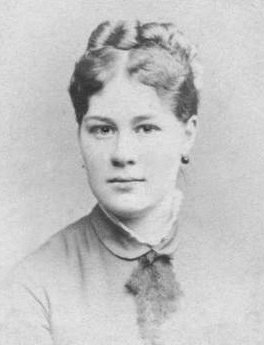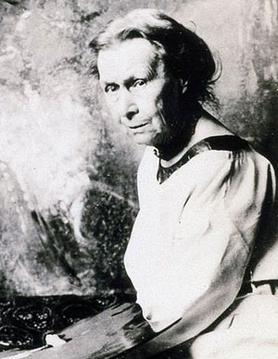
Eliza Cecilia Beaux was an American artist and the first woman to teach art at the Pennsylvania Academy of the Fine Arts. Known for her elegant and sensitive portraits of friends, relatives, and Gilded Age patrons, Beaux painted many famous subjects including First Lady Edith Roosevelt, Admiral Sir David Beatty and Georges Clemenceau.

Vanessa Bell was an English painter and interior designer, a member of the Bloomsbury Group and the sister of Virginia Woolf.

Frances Mary Hodgkins was a New Zealand painter chiefly of landscape and still life, and for a short period was a designer of textiles. She was born and raised in New Zealand, but spent most of her working life in England. She is considered one of New Zealand's most prestigious and influential painters, although it is the work from her life in Europe, rather than her home country, on which her reputation rests.
Alison Watt OBE FRSE RSA is a British painter who first came to national attention while still at college when she won the 1987 Portrait Award at the National Portrait Gallery in London.

David Jagger (1891–1958) was an acclaimed and prolific English portrait painter. He was renowned for his commissioned portraits of London's high society and British aristocracy. Notable portraits include those of Robert Baden-Powell (1929), Queen Mary, King George VI (1937), Winston Churchill (1939), Vivien Leigh (1941) and Prince Philip, Duke of Edinburgh (1958).
Elizabeth Joan Glass (1915–2000), was an English textile designer and painter.

Charles Sargeant Jagger was a British sculptor who, following active service in the First World War, sculpted many works on the theme of war. He is best known for his war memorials, especially the Royal Artillery Memorial at Hyde Park Corner and the Great Western Railway War Memorial in Paddington Railway Station. He also designed several other monuments around Britain and other parts of the world.

Annie Louisa Swynnerton, ARA was a British painter best known for her portrait and symbolist works. She studied at Manchester School of Art and at the Académie Julian, before basing herself in the artistic community in Rome with her husband, the monumental sculptor Joseph Swynnerton. Swynnerton was influenced by George Frederic Watts and Sir Edward Burne-Jones. John Singer Sargent appreciated her work and helped her to become the first elected woman member at the Royal Academy of Arts in 1922. Swynnerton painted portraits of Henry James and Millicent Fawcett. Her main public collection of works are in Manchester Art Gallery, but individual works are also held in a few other English cities, as well as can also be seen in Glasgow, Dublin, Paris, and two in Melbourne, Australia. Annie was a close friend of leading suffragists of the day, notably the Pankhurst family.

Stanisława de Karłowska was a Polish-born artist who was a founder member of the London Group. Her work combined a modernist style with elements of Polish folk art.

Edith Corbet née Edenborough was a Victorian landscape painter, having close associations with the Macchiaioli group, who, in a break with tradition, painted outdoors in order to capture natural light effects and favoured a panoramic format for their paintings.

Annie Elizabeth Kelly was a New Zealand artist. She was the first New Zealand woman to receive the CBE for services to art.
Sandra Meigs is a Canadian visual artist. She is based in British Columbia, Canada. Her paintings have been exhibited in Canada and internationally and she is a member of the Royal Canadian Academy of Arts.

Edith Jeanette Soterius von Sachsenheim (1887–1970) was a Transylvanian Saxon painter, who spent part of her career in England and elsewhere in Europe.

Florence Aline Rodway was an Australian artist best known for her portraits. Born in the Tasmanian city of Hobart, she was the second of six children to Leonard Rodway and Louisa Susan, née Phillips. She studied painting at the Hobart Technical College ; after two years her work was sent to London, and she was awarded a three-year scholarship to study painting at the Royal Academy of Arts, London. She is best known for having painted portraits of notable figures in Australian history, including Dame Nellie Melba, William Bridges, J. F. Archibald and Henry Lawson.

Annie Shepley Omori was an American artist, activist, and translator. For the first fifty years of her life, she produced work under her maiden name, Annie Barrows Shepley. She studied art in New York under Harry Siddons Mowbray and in Paris at Académie Julian under Jules Joseph Lefebvre and Lucien Simon. After that, she established studios in New York and Connecticut, where she worked as a portrait painter and children's book illustrator. She married Hyozo Omori, a Japanese exchange student, in 1907 and moved with him to Japan, where they established the Yurin En settlement house to provide educational and recreational opportunities to the poor in Tokyo. They were leaders in the Japanese playground movement. Hyozo Omori died in 1913, and Shepley continued running the center. She also translated Diaries of Court Ladies of Old Japan with Kochi Doi in 1920.
Annie Bindon Carter (1883–1969) was a British entrepreneur, businesswoman and philanthropist.
Edith Varian Cockcroft was a Brooklyn-born painter, designer, inventor and ceramist, who exhibited at venues including the Paris Salon, National Academy of Design and Art Institute of Chicago. She was known for portraits of nudes posed against vibrant fabric backdrops as well as landscape paintings, often depicting European seacoasts. She patented and exhibited silks and velvets, produced ceramic dinnerware and designed clothing and theater sets. Her artworks were lauded for "boldness of decorative pattern and fearless use of color" and for their "character and vigor." Among the customers for her garments were the performers Irene Castle and Jeanette MacDonald Edith typically signed her paintings and ceramics "E. Varian Cockcroft" or "Cockcroft," and it was reported in 1920 that her works "have such a strong masculine quality that she is generally thought to be a man." She was a member of the Société Nationale des Beaux Arts and the National Association of Women Painters and Sculptors, and she was a founding member of the New York Society of Women Artists.

Edith Grace Wheatley née Wolfe was a British artist who had a long career as a painter of figures, flowers, birds and animals and as a sculptor.

Edith Bry (1898–1991) was an American painter, printmaker, and glass artist. During her long career she combined technical skill with an impulse to innovate. Critics noted her versatility, pointing to skill in handling oil painting, lithography, etching, drawing, watercolor, and wood carving. Her style ranged from realist to abstract and from what one critic called a "discipline of an inner reticence" to a "more dynamic emotional expressionism." Her early-career still lifes drew praise and a figure-group called "Exiles" received much attention following its acquisition by the Metropolitan Museum of Art. Her mid-career work was more expressive and abstract as she tried, as she put it, to rid herself "from the tyranny of nature." At the end of her career she was particularly known for semi-abstract work in glass and enamel, mainly of religious subjects.
Catherine Gardiner was a British theatre actress, artists' model, amateur golfer and amateur artist. She was married to the portrait painter David Jagger RP, ROI (1891-1958).













